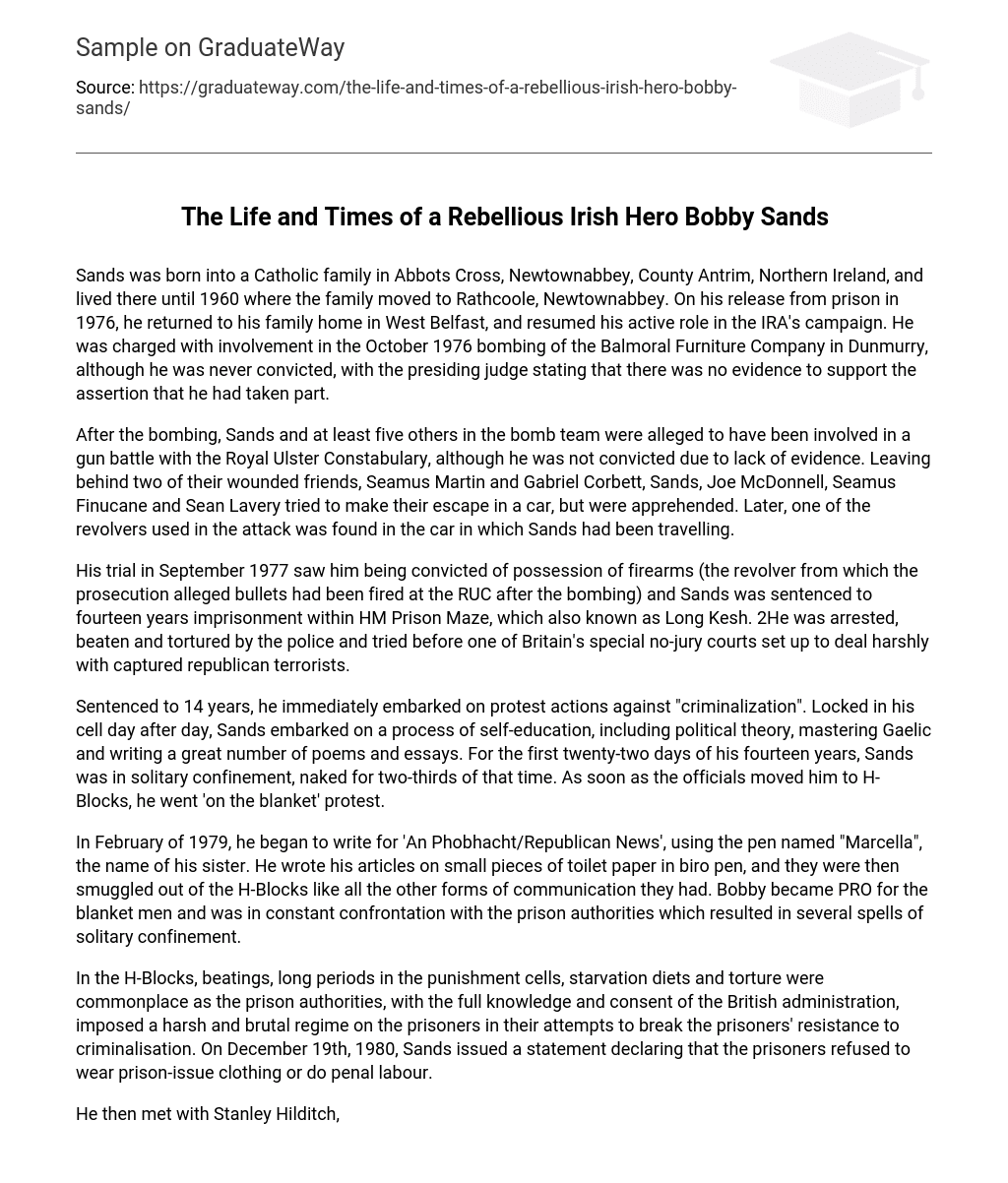Sands was born into a Catholic family in Abbots Cross, Newtownabbey, County Antrim, Northern Ireland, and lived there until 1960 where the family moved to Rathcoole, Newtownabbey. On his release from prison in 1976, he returned to his family home in West Belfast, and resumed his active role in the IRA’s campaign. He was charged with involvement in the October 1976 bombing of the Balmoral Furniture Company in Dunmurry, although he was never convicted, with the presiding judge stating that there was no evidence to support the assertion that he had taken part.
After the bombing, Sands and at least five others in the bomb team were alleged to have been involved in a gun battle with the Royal Ulster Constabulary, although he was not convicted due to lack of evidence. Leaving behind two of their wounded friends, Seamus Martin and Gabriel Corbett, Sands, Joe McDonnell, Seamus Finucane and Sean Lavery tried to make their escape in a car, but were apprehended. Later, one of the revolvers used in the attack was found in the car in which Sands had been travelling.
His trial in September 1977 saw him being convicted of possession of firearms (the revolver from which the prosecution alleged bullets had been fired at the RUC after the bombing) and Sands was sentenced to fourteen years imprisonment within HM Prison Maze, which also known as Long Kesh. 2He was arrested, beaten and tortured by the police and tried before one of Britain’s special no-jury courts set up to deal harshly with captured republican terrorists.
Sentenced to 14 years, he immediately embarked on protest actions against “criminalization”. Locked in his cell day after day, Sands embarked on a process of self-education, including political theory, mastering Gaelic and writing a great number of poems and essays. For the first twenty-two days of his fourteen years, Sands was in solitary confinement, naked for two-thirds of that time. As soon as the officials moved him to H-Blocks, he went ‘on the blanket’ protest.
In February of 1979, he began to write for ‘An Phobhacht/Republican News’, using the pen named “Marcella”, the name of his sister. He wrote his articles on small pieces of toilet paper in biro pen, and they were then smuggled out of the H-Blocks like all the other forms of communication they had. Bobby became PRO for the blanket men and was in constant confrontation with the prison authorities which resulted in several spells of solitary confinement.
In the H-Blocks, beatings, long periods in the punishment cells, starvation diets and torture were commonplace as the prison authorities, with the full knowledge and consent of the British administration, imposed a harsh and brutal regime on the prisoners in their attempts to break the prisoners’ resistance to criminalisation. On December 19th, 1980, Sands issued a statement declaring that the prisoners refused to wear prison-issue clothing or do penal labour.
He then met with Stanley Hilditch, the prison governor, to try to negotiate a way of scaling back the protests gradually. However, these efforts to show flexibility produced no results from the officials. The prisoners were still expected to conform, which would mean allowing themselves to have criminal status imposed on them. But the prisoners recognized that by accepting criminal status they would be providing a precedent for the British to criminalize Irish freedom fighters and thus the IRA itself, and they refused to yield.
Sands requested permission to lead a second hunger strike. Certain of his death, he insisted that he be allowed start two weeks before any other strikers – that way, perhaps his death could get the British to yield on the five demands and the others would survive. For the first seventeen days, Sands kept a secret diary in which he described not only the day-to-day results of the fast but also his views on the strike itself.
He felt that the strike was for the sake of not only the five demands but also as a larger battle against British rule in Ireland. The struggle inspired the imaginations and social consciences of people throughout the world. A mass movement arose in solidarity with the hunger strikers, a movement which invented its anger and resentment that was slowly murdering them. On April 19, Sands was elected to Westminster, in a massive outpouring of popular sympathy which shocked the British establishment. On May 5, Bobby Sands finally succumbed, undefeated.
The world stopped to watch his funeral two days later, hundreds of thousands worldwide going on strike and demonstrating against the British government’s arrogance and cruelty. Well over 100,000 people marched behind Bobby Sands’ coffin through his own Twinbrook Estate to Milltown cemetery. A lone piper marched at the head of the procession, playing a song made famous by the hunger strikers: “I’ll wear no convict’s uniform, nor meekly serve my time, that Britain may call Ireland’s fight 800 years of crime. At the end, three IRA volunteers, amidst the cheers and tears of those around them, fired the volley that is the traditional republican tribute to the fallen hero. And hero he was. He towers over those who sent him to his death. He was murdered because he wouldn’t give in, in the face of injustice. In Bobby Sands’ own words: “If they aren’t able to destroy the desire for freedom, they won’t break you. They won’t beat me because the desire for freedom is in my heart. “





